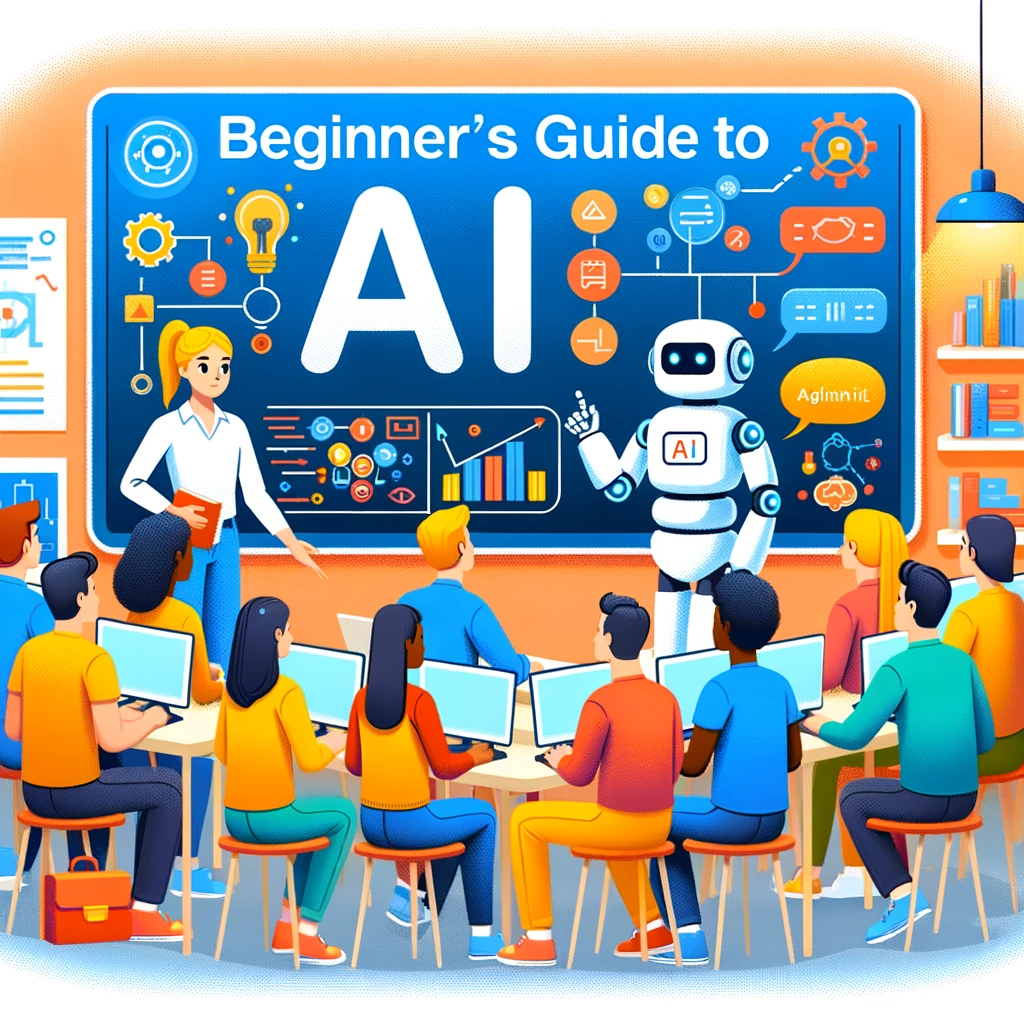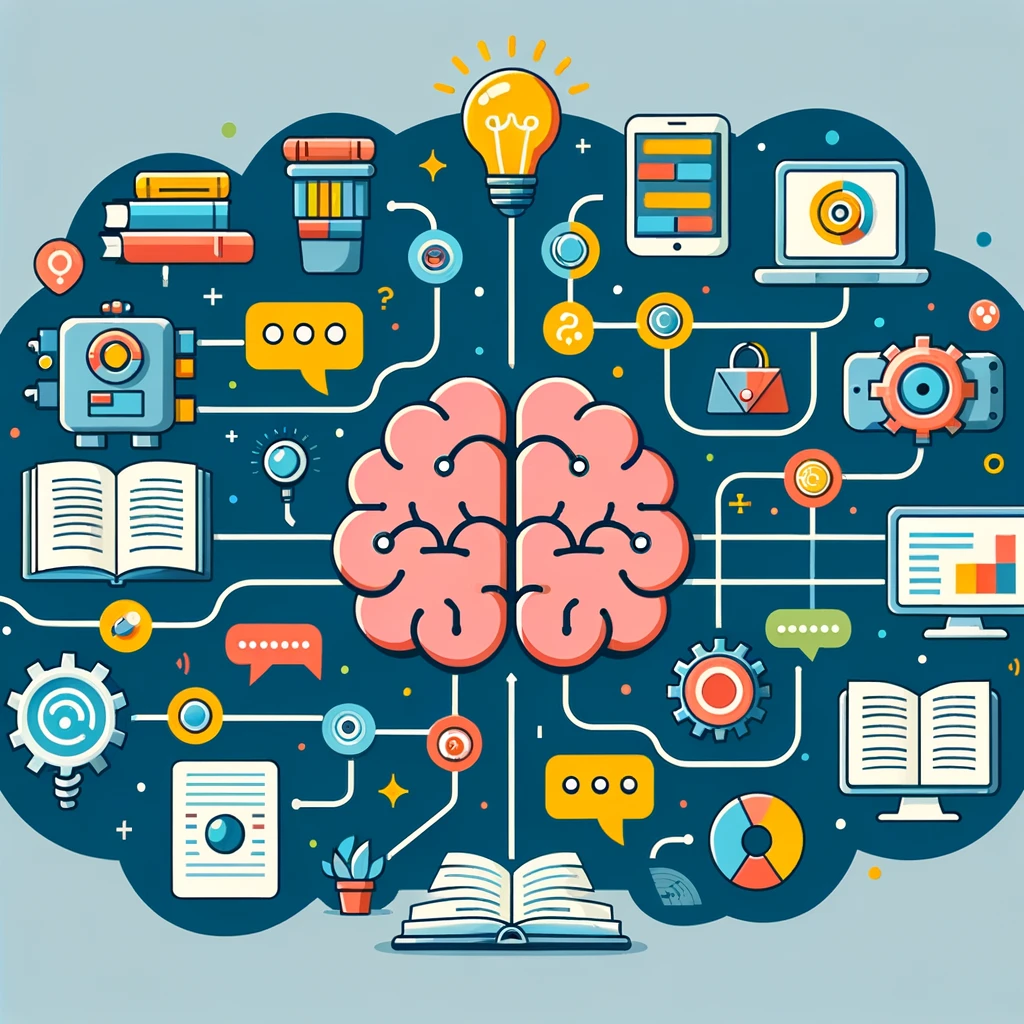Artificial intelligence (AI) operates through a multi-step process, fundamentally transforming how machines learn and function. You may want to take a look at What is Artificial Intelligence (AI)? where we explain what artificial intelligence is. The journey of creating an AI system involves:
Data Collection: AI starts with gathering extensive data, which can vary from text, images, to audio and video. This data serves as the foundation for training AI systems.
Data Preprocessing: Raw data is refined for accuracy and relevance. This involves noise removal, data smoothing, and formatting, ensuring the AI receives high-quality information.
Model Selection: The appropriate AI model is chosen based on factors like data quantity, time constraints, resources, data type, and budget. Options include machine learning algorithms, deep neural networks, or hybrid models.
Training the Model: The AI model learns from the processed data, divided into training and validation sets. The training set educates the model, while the validation set evaluates its effectiveness.
Testing and Evaluation: Post-training, the model’s performance is rigorously tested against a validation dataset to measure accuracy, precision, and recall, and to identify any biases or errors.
Model Optimization: The AI model undergoes fine-tuning to improve performance. This may involve adjusting parameters, modifying the model’s architecture, or employing regularization techniques to avoid overfitting.
Deployment: The AI model is integrated into existing systems or new applications, where it processes real-world data to provide insights or automated functions.
Continuous Learning: AI systems require regular updates with new data to maintain accuracy and relevance. This can be achieved through base model fine-tuning or reinforcement learning with human feedback.
Also you can find our video on how AI works below.
In essence, AI works by leveraging large datasets and intelligent algorithms, allowing the software to identify patterns and features in data. This process enables AI to perform cognitive tasks previously thought to be exclusive to human intelligence, such as understanding natural language, recognizing images, and making complex decisions. AI technology is continuously evolving, driven by advancements in machine learning, neural networks, and deep learning, pushing the boundaries of what machines can learn and accomplish.
How to use AI for Beginners?
For beginners eager to understand and use artificial intelligence (AI), the process involves acquiring fundamental skills and gradually advancing to more complex concepts and tools. Here’s a concise guide:
Build Foundational Skills: Start with mastering basic statistics and mathematics. This includes understanding statistical concepts and mathematical principles crucial for AI, like calculus and linear algebra. Programming is another essential skill, with Python being the most preferred language due to its simplicity and rich library ecosystem.
Learn Core AI Concepts: Dive into the core areas of AI such as data structures, data manipulation, machine learning, and deep learning. Understanding these concepts is vital for creating and implementing AI algorithms and models.

Familiarize with AI Tools and Packages: Gain practical experience by using popular AI tools and packages, especially those related to Python, such as Pandas for data manipulation, NumPy for numerical computations, and machine learning libraries like Scikit-Learn, PyTorch, and Keras.
Specialize and Keep Learning: AI is a vast field, so choose areas you’re passionate about for specialization, like natural language processing or computer vision. Continuously update your knowledge with the latest developments in AI, engage in community discussions, and work on real-world projects.
Apply AI Ethically: As you progress, it’s important to understand and consider the ethical implications of AI applications.
Develop a Learning Plan: A structured learning plan helps you stay focused and track your progress. Begin with the basics and gradually move to advanced topics, adjusting the pace according to your learning style and career goals.
Remember, AI is a rapidly evolving field, so continuous learning and adaptation are key. Start with a strong foundation and progressively build your skills through practice and real-world application.
How does Artificial Intelligence Work in Simple Language?
Artificial Intelligence (AI) works by combining large volumes of data with intelligent algorithms, enabling machines to learn from patterns and features within the data. Essentially, AI follows these steps:
Input: AI systems receive data, which can range from text to images or speech. The data is collected and fed into the AI system for processing.
Processing: In this stage, AI analyzes the input data. It uses pre-programmed algorithms to recognize patterns and behaviors within the data. This process is crucial for AI to make decisions or predictions based on the given data.

Data Outcomes: After processing, AI predicts outcomes based on the data. It evaluates whether the predictions are successful or if there are errors.
Adjustments: If AI encounters errors, it learns from these mistakes and adjusts its algorithms accordingly. This ability to learn from errors and adapt is a key feature of AI.
Assessments: Finally, AI assesses its performance. It analyzes the data and its decisions, making inferences and predictions, and provides feedback for future improvements.
AI technology involves several concepts, including machine learning (where machines improve from experience), deep learning (using large neural networks for complex pattern recognition), and neural networks (mimicking the human brain’s interconnected neuron system).
Different types of AI work in various ways, from simple reactive machines that respond to data without memory to more advanced forms that can understand emotions or even have self-awareness. However, fully self-aware AI is still a concept in development.
How AI is Created?
Creating Artificial Intelligence (AI) involves several key steps: identifying a problem to solve, gathering relevant data, designing algorithms, and building AI models. The journey of AI began in the 1950s with early research into problem-solving and symbolic methods. Key historical milestones include the U.S. Department of Defense’s projects in the 1960s and DARPA’s development of intelligent personal assistants in 2003. AI’s evolution was driven by increased data volumes, advanced algorithms, and improved computing power.
Where does AI Get Data From?
Artificial Intelligence (AI) sources its data from a variety of places, vital for its learning and predictive abilities. Key sources include:
Databases and Data Repositories: AI systems frequently use data from online databases, public records, and institutions that compile and organize data.
Web Data Collection: AI employs web scraping techniques, utilizing bots to extract specific data points like product prices or customer reviews from websites. This data is essential for AI to conduct pattern recognition and aid in business decision-making.

Social Media and E-commerce Sites: Platforms like social media and e-commerce sites are goldmines of user activity data. AI analyzes this data for personalized feeds, product recommendations, and targeted advertisements.
Healthcare and Travel Websites: AI in these sectors collects patient behavior, medical history, customer preferences, and travel patterns to offer personalized plans and recommendations.
Proxy Services: Services like ProxyEmpire.io help AI by providing a network of proxies for anonymous, unrestricted data collection, crucial for web scraping and data gathering without detection.
Internal Company Data: AI often uses an organization’s own data, like customer interactions and sales figures, for predictive analytics and decision-making.
Public Data Sets: AI taps into public domain resources like books, scientific journals, and Wikipedia for diverse, unrestricted data.
Crowdsourcing and Synthetic Data: Gathering data through crowdsourcing or generating synthetic data using other AI models are innovative methods for training AI systems.
User-Generated Content: Data from social media, forums, and blogs offers rich, real-world insights for AI learning.
AI thrives on diverse, voluminous data sources to enhance its accuracy and effectiveness in various applications, from customer service to medical diagnostics.
What are the Requirements for AI Technology?
Creating successful AI technology requires a multifaceted approach, integrating scientific, application, and stakeholder consistency. Scientific consistency involves training AI models to accurately reflect reality, requiring activities like comparing AI output with empirical evidence and making necessary adjustments to data, algorithms, or domain knowledge. Application consistency ensures the AI model not only achieves accuracy but also fulfills intended goals and avoids unintended consequences, necessitating scoping activities to evaluate impacts and adjust model limitations and oversight. Stakeholder consistency is about aligning the AI solution with the diverse needs of stakeholders like managers, workers, investors, customers, citizens, and regulators. This involves creating value recognized, supported, and benefited from by all stakeholders.
Moreover, successful AI demands substantial computing resources and infrastructure. Organizations need to invest in high computing capacity, including CPUs and GPUs, to handle complex AI workloads. Storage capacity is crucial, as AI applications generate large volumes of data. A robust networking infrastructure is necessary to support the bandwidth and latency requirements of deep learning algorithms. Security is paramount, especially when handling sensitive data. Cost-effective solutions are essential to manage the growing expenses of complex AI models.
AI also thrives on large, high-quality data sets. Approximately 60% of AI project time is spent cleansing and preparing data. Both internal and external data sources are utilized, often requiring augmentation and careful consideration of data quality. Cloud technologies, particularly hybrid cloud solutions, are foundational for AI’s data needs, offering a scalable infrastructure that matches the technology demands at an appropriate cost level.
How does AI Work in Steps?
Artificial Intelligence (AI) functions through a series of steps, starting with understanding the goal and performance needs of the model. This involves defining the problem to be solved, assessing if AI is the best solution, and establishing performance metrics like accuracy. AI models are not flawless, but they aim for high accuracy, especially in complex tasks.
The second step involves assessing the level of rigour required for the AI task. Not all AI tasks need interpretability, but for critical applications like financial fraud detection, understanding the AI’s decision-making process is essential.
The third step is understanding the impact on stakeholders and regulatory requirements. This includes ensuring the AI system’s interpretability to satisfy all parties affected by its operations and comply with relevant regulations.
In the fourth step, the specific need for interpretability is considered. Different stakeholders may have varying needs for explainability, such as trust or the ability to act on AI results.
The final step is developing and implementing the model strategy. This could involve using simpler AI models for better interpretability or adding frameworks to complex models for explainability.
Overall, AI works by combining vast data sets with advanced algorithms and fast processing, allowing systems to learn from patterns and improve performance iteratively. The process involves balancing between model complexity, performance, stakeholder needs, and regulatory compliance.
What Technical Skills do You Need to be an AI Engineer?
To become an AI engineer, one needs a blend of technical and non-technical skills. Key technical skills include:
Programming Languages: Proficiency in languages like Python, Java, R, C++, and JavaScript is essential. Python is particularly favored for its simplicity and powerful libraries like TensorFlow, Keras, and PyTorch.
Data Modeling and Engineering: Skills in acquiring, cleaning, and transforming data, as well as SQL and NoSQL database knowledge, are critical.
Big Data Analysis: Ability to work with large datasets using tools like SparkSQL, Apache Flink, and Google Cloud Platform.
Machine Learning Models: Understanding of supervised and unsupervised learning, deep learning algorithms (CNNs, RNNs), and performance evaluation metrics.
AI and ML Services: Familiarity with cloud-based services from AWS, Azure, and Google Cloud Platform, offering pre-built models and tools.
AI Deployment & DevOps: Skills in using Docker, Kubernetes, and other tools for deployment, configuration management, and system maintenance.
AI Security: Knowledge of data security, privacy measures, and relevant regulations like GDPR.
Non-technical skills include:
Communication and Collaboration: Effective communication with both technical and non-technical stakeholders and teamwork skills.
Adaptability and Continuous Learning: Keeping up-to-date with the rapidly evolving AI field.
Critical Thinking and Problem-Solving: Ability to think critically and solve complex problems in AI project execution.
Domain Knowledge: Specialized knowledge in the specific area of AI application.
Advanced skills for seasoned AI engineers involve:
Advanced Mathematics and Algorithm Knowledge: Profound understanding of linear algebra, calculus, and statistics.
Neural Network Architectures: Skills in developing and applying various neural network types.
Overall, an AI engineer must blend these diverse skills to design, develop, and maintain sophisticated AI systems.










